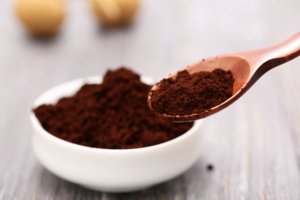The hypoglycaemic effects of various extracts from Ganoderma lucidum have been studied in different animal models of diabetes and in in vitro experiments to identify mechanisms. The main in vitro, animal and clinical studies investigating the hypoglycaemic effects of Ganoderma lucidum are summarised in , respectively.
In vitro studies on the hypoglycaemic effects of Ganoderma lucidum
1. Polysaccharides from the fruiting body of Ganoderma lucidum showed a protective effect on alloxan-induced pancreatic islet damage;
2. Methanol extract of Ganoderma lucidum showed the highest aldose reductase inhibitory activity;
3. Ganoderic acid showed potent human aldose reductase inhibitory activity;
4. Ganoderol B from Ganoderma lucidum extract is identified as an active α-glucosidase inhibitor;
5. Proteoglycan extracted from Ganoderma lucidum inhibited PTP1B overexpression, improved IRS1 phosphorylation, activated PI3K/Akt cascades, increased phosphorylation of GSK3β, enhanced insulin-stimulated glycogen synthesis;
6. Proteoglycan extracted from Ganoderma lucidum increased insulin-stimulated glucose uptake, inhibited PTP1B expression, increased IRS1 phosphorylation, activated PI3K/Akt, increased phosphorylation of AMPK and up-regulated expression of GLUT4.
*Akt: protein kinase B;
*AMPK: adenosine monophosphate-activated protein kinase;
*GLUT4: glucose transporter type 4;
*GSK3β: glycogen synthase kinase-3β;
*IRS1: insulin receptor substrate 1;
*PI3K: phosphatidylinositol-3 kinase;
*PTP1B: protein tyrosine phosphatase 1B.
Animal studies on the hypoglycaemic effects of Ganoderma lucidum.
1. Water extracts (104mg/kg crude drug equivalent, i.p.) of the fruiting bodies of Ganoderma lucidum for 7 or 27h reduced plasma glucose and 2 glycans, ganoderans A and B, with hypoglycaemic action isolated;
2. Ganoderan B increased insulin and altered enzyme activities;
3. Ling Zhi-8 immunomodulatory protein (10.3−12.6mg/kg twice weekly) from 4 weeks of age, followed up to 42 weeks of age, prevented development of autoimmune diabetes by immunosuppressive mechanism;
4. Pre-treatment with intragastric Polysaccharides (50−200mg/kg) for 10 days partly protected beta cells from necrosis;
5. Polysaccharides (25−100mg/kg) given by single intraperitoneal injections Reduced serum glucose and increased insulin levels;
6. Polysaccharides (125 and 250mg/kg) given for 8weeks reduced serum glucose, increased insulin levels and delayed progression of diabetic renal disease;
7. Water extract of Ganoderma lucidum (0.003, 0.03 and 0.3g/kg) for 4 weeks reduced serum glucose and liver;
8. Polysaccharides at low (50mg/kg) and high (150mg/kg) dose for 28 days reduced serum glucose, increased insulin levels and improvements in blood lipids;
9. Proteoglycan from Ganoderma lucidum (50 and 150mg/kg, oral dose) for up to 4 weeks reduced plasma glucose with effect comparable with metformin;
10. Proteoglycan from Ganoderma lucidum (40 and 120mg/kg, oral dose) for 30 days reduced plasma glucose, increased insulin and inhibited PTP1B;
11. Low-molecular-weight Polysaccharides (200mg/kg) orally for 8 weeks reduced serum glucose appeared related to protection of pancreatic β-cells;
12. Polysaccharides from Ganoderma lucidum (50 or 100mg/kg/day) given for 7 days reduced fasting serum glucose and insulin levels;
13. Proteoglycan from Ganoderma lucidum (75, 250, or 450mg/kg) for 8 weeks reduced HbA1c, increased insulin and C-peptide levels, increased glucokinase and lowered PEPCK activities;
14. Ganoderma lucidum extract (200, 400, 600 and 800mg/kg/day) for 7 days reduced fasting and postprandial plasma glucose and HbA1c, increased plasma insulin levels and improved lipid profile;
15. Polysaccharides from Ganoderma lucidum (50mg/kg/day) decreased fasting serum glucose, fasting serum insulin and liver glucose regulatory enzymes;
16. Ethanol extract of Ganoderma lucidum fruiting bodies (250, 500 and 1000mg/kg) for 14 days reduced blood glucose and HbA1c dose-dependently, and increased insulin.
* HbA1c: Glycosylated Haemoglobin Level;
* PEPCK: phosphoenolpyruvate carboxykinase;
* PTP1B: protein tyrosine phosphatase.
Clinical studies on the hypoglycaemic effects of Ganoderma lucidum.
1. Multi-centered randomised controlled trial of GanopolyTM 1800mg 3 times daily versus placebo for 12 weeks: Reduction in HbA1c and fasting and postprandial plasma glucose levels with GanopolyTM;
2. Randomised, double-blind, placebo-controlled dry extract of Ganoderma lucidum 3000mg or placebo for 12 weeks: No changes in fasting glucose or HbA1c but the plasma glucose area under the curve during a meal tolerance test was reduced more with Ganoderma lucidum extract;
3. Randomised, double-blind, cross-over study with a Lingzhi product 1.44g daily or placebo for 12 weeks: No significant effect on HbA1c, fasting plasma glucose, blood pressure or lipids. Plasma insulin and HOMA-IR reduced with Lingzhi compared to placebo;
4. Randomised controlled trial of Ganoderma lucidum 3g/day or Ganoderma lucidum plus Cordyceps sinensis capsules, versus placebo for 16 weeks: No significant effect on HbA1c, fasting plasma glucose, blood pressure or lipids.
* HbA1c: Glycosylated Haemoglobin Level;
* HOMA-IR: homeostasis model assessment-insulin resistance;
* T2DM: type 2 diabetes mellitus.

Leave A Comment